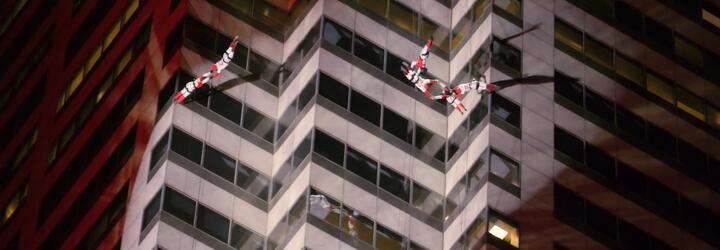
Dodd Technologies and Elation Proteus meet lofty challenge at College Football Playoff in Indianapolis
Dodd Technologies, a full service live events production company in Pendleton, Indiana, near Indianapolis, had a busy start to the year thanks to the College Football Playoff national championship game, which took place at Indianapolis’s Lucas Oil Stadium on January 10th. Dodd (www.doddtechnologies.com) worked on several projects associated with the game including a remarkable high-rise ballet lit using Elation’s 50,000-lumen Proteus Maximus™.
Vertical dance
The CFP national championship presented a unique opportunity for the city to shine. Over the weeklong festivities, Dodd lit up the JW Marriott hotel and Lucas Oil Stadium, along with a series of concerts by national acts that took place at Monument Circle in downtown Indianapolis. One of the more extraordinary events however took place high above Monument Circle on the 701’ tall Salesforce Tower, where a vertical dance troupe performed across the façade of the building.
“The College Football Playoff gave the city the chance to step into the national spotlight and was a nice opportunity to jump start events again,” commented Andy Meggenhofen, lighting and production designer at Dodd Technologies. “One of the more unique happenings the city planned was a performance by a group called Bandaloop, an aerial dance company that perform choreographed dance on the side of high-rise buildings using climbing equipment. We were called on to light the performance, but with wintry weather and performers hundreds of feet up on the side of a building, we were faced with a number of challenges.”
IP with horsepower and framing
The aerial troupe, who custom-choreographed the show based on the building architecture, performed at night between the 23rd and 49th floor of the high-rise. The unique circumstances demanded an exceptional lighting fixture. “We required quite a bit of horsepower and also needed a fixture with shuttering capability and the Proteus Maximus fulfilled both of those roles. We also needed an IP-rated fixture that could stand up to the demands of working high up on a skyscraper in the winter,” Meggenhofen stated.
This was the first time that the CFP national championship game has taken place in a cold weather city and true to the season, there was a lot of freezing weather. “We had an ice storm one night and single digit temperatures throughout,” Meggenhofen says, “but it was probably even lower 700 feet up in the air. One of our concerns was how were these fixtures going to deal with being exposed for eight days.”
Maximus top and bottom
Meggenhofen and his team mounted four Proteus Maximus on top of the building on 12” x 12” truss that hung out over the edge of the building, far enough so that the fixtures could fully rotate. From below, nine Maximus provided uplighting onto the building from positions across the street. In addition, twelve other IP-rated fixtures were used for base lighting.
“A big purpose of the uplighting was to better capture the event on camera,” said Meggenhofen, noting that there were three camera positions, one on the building, another 600 ft away, plus a drone camera. “To maintain a proper field of light for the cameras, we wanted to make sure we had enough horsepower and the Maximus were vital for that.”
Theatrical look and feel
Color and pattern bathed the building while illuminating the dancers themselves, their shadows mimicking the dance that played out across the façade. Meggenhofen says that taking a theatrical show outside into the elements, although a challenge, and especially at such a distance, the focus was to remain on the art. “Even though it was extreme conditions, the expectation was to have a theatrical look and feel,” he said. “This was all about the finesse and subtlety of a theatre show, we just happened to be doing it under extreme conditions on the side of a building from distances that are 10 times what they normally would be. They aren’t typical positions that you would light!”
Meggenhofen utilized a lot of shuttering, which he says provided a dramatic effect from the top. “Repeatability was a huge factor. We wanted to make sure that a lot of the cuts from the top fixtures down were cutting off the building and onto the performers. Fixtures from the bottom shooting up had to have some nice hard cuts as well.” Overnight, the fixtures were programmed in a slow pan/tilt chase, which the designer says created a beautiful architectural feature. Overall, he was quite happy with the luminaires. “We had no problems with them. They performed flawlessly and really read well on camera.”
Team logos
Dodd Technologies employed other Elation lights elsewhere in the city, namely high-power CW Profile HP IP™ IP65-rated ellipsoidals to project team logos (Apollo gobos) onto building facades. According to Meggenhofen, the CW Profile’s high color temperature really helped with accurate color reproduction. He explains, “One of the teams had crimson as their colors (Alabama) and the other red (Georgia) but it was an important difference. Making that separation between the red and crimson was a detail we wanted to accurately reproduce and that came off well. We’ve been extremely happy with those.” He adds that although most of the CW Profiles were positioned outside, two fixtures were positioned inside an office, which, because they are virtually silent, disturbed no one.
Elation product support on the project came from manufacturer rep firm Five Lakes Marketing, with whom Dodd has a longtime relationship. “The rapport with Ed Cheeseman at Five Lakes and Elation has been really good over the years. There are a lot of things that we work on that is not necessarily normal production work so we often need unique solutions to some of the challenges we face. Ed is only a phone call away and the team at Elation is always responsive,” Meggenhofen concludes.
Andy Meggenhofen: Account Manager
Jim French: Bandaloop Lighting Designer and Programmer
Jason Lenhart: ME#1
Trystan Adams: ME#2






